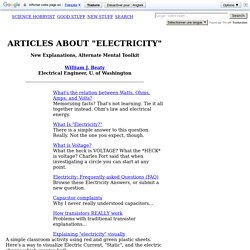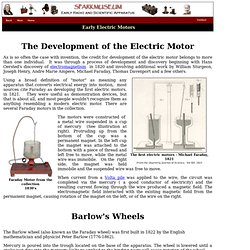

Physics Teacher Resources. Neodymium supermagnet demonstrations, DIY magn. Articles on "Electricity" . . . . WJ Beaty. Why three prongs?

Why do wall outlets have three holes? "Grounding" and safety. Right Angle CircuitryDo Lenz' Law and the Right Hand rule still work... after you've been turned INSIDE OUT by that greasy black Fog? "Static Electric" misconceptionsA list of things which gave me a warped view of Electrostatics. Once I recognized their existence, I was able to fight free of them. Speed of "Electricity"? Triboelectric Series If a cat gets trapped in a clothes dryer full of nylon pantyhose, which way do the electrons flow?
Where does EM energy flow in a circuit? How Scientists Define the word "Electricity" Quotes from J.C. Barriers to Understanding ElectricityTwenty misconceptions which prevented me from understanding simple electrical science as a student. "Static" Electricity is really just high voltage.Scuff on the rug, then measure your body voltage. Electricity mistakes and 'nitpicking' also How SHOULD we teach Electricity? The Electricity MapHow are batteries different than static cling? How to make the simplest electric motor. You have one drywall screw, one 1.5 V alkaline cell, six inches of plain copper wire, one small neodymium disk magnet, and no other tools or supplies.

You have 30 seconds to make an electric motor running in excess of ten thousand RPM. Can you do it? Surprisingly enough, you can. Let’s take a step back. The most common type of electric motor is the brushed dc electric motor. A simpler yet motor (sometimes sold as the sold as the “world’s simplest motor“) just switches off the current for half of the cycle, letting the angular momentum of the spinning motor armature carry it through.
Homopolar Motor With Five Speed Manual Stick-Shift. This video show how to build a homopolar motor that's really different...it's got a five-speed shifter!

The homopolar motor is the simplest design electrical motor in the world. It uses a battery, a neodymium magnet and a wire. Usually, either the copper wire or the magnet rotates. In this case the battery rotates. Here, I've used a battery, a neo magnet, and a copper wire wrapped around a coat-hanger. I've been recently told that US coins, being non-magnetic, won't work for this Instructable. You can order the BEST neodymium super-magnets from K&J Magnetics here. See more of my homopolar motor videos at : How to Make a Simple Homopolar Motor Video. Motors. The Development of the Electric Motor As is so often the case with invention, the credit for development of the electric motor belongs to more than one individual.

It was through a process of development and discovery beginning with Hans Oersted's discovery of electromagnetism in 1820 and involving additional work by William Sturgeon, Joseph Henry, Andre Marie Ampere, Michael Faraday, Thomas Davenport and a few others. Using a broad definition of "motor" as meaning any apparatus that converts electrical energy into motion, most sources cite Faraday as developing the first electric motors, in 1821. They were useful as demonstration devices, but that is about all, and most people wouldn't recognize them as anything resembling a modern electric motor. There are several Faraday motors in the collection. The motors were constructed of a metal wire suspended in a cup of mercury (See illustration at right). Barlow's Wheels Mercury is poured into the trough located on the base of the apparatus. K&J Magnetics - Product Categories. SATURN MAGNET BEDINI. How to Make a Bedini Motor. Bedini Motors. Homopolar Motor Demonstration.
Neodymium Magnets by Gaussboys Super Magnets. NdFeB Magnets, Magnet Wire, Books, Weird Science, Needful Things. As we discussed on our diamagnetism main page, water is diamagnetic, though about 20 times less than Carbon-Graphite or Bismuth.

When exposed to a magnetic field, it produces a weak magnetic field in the opposite direction. Also, this means it is repelled by a magnetic field. This page shows some simple experiments that demonstrate the diamagnetic properties of water. One of our goals up here at Wondermagnet Laboratories is to get a tiny drop of water to levitate above four permanent magnets.
It's probably not possible with currently available grades of magnet, but as N-I-B magnets improve in quality, it may be possible soon. Experiment 1 -- Oil Drops and Water Fill a small glass jar 2/3 full with rubbing alcohol. Add a bunch more tiny oil droplets, set on a countertop, and place a large N-I-B magnet or stack of magnets next to the jar. The magnet is repelling the water in the mixture, causing the oil droplets to collect at the area of strongest magnetic field. Diamagnetic Icicle.